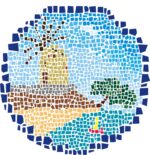
The Municipal Unit of Ormylia consists of the Municipal Department of Ormylia (Vatopedi, Evangelismos of Theotokos, Nea Sermyli, Nissi, Saint Arsenios, Vatopedi Beach, Psakoudia) and the Municipal Department of Metamorphosis.
Ormylia
Ormylia is located at the entrance of the Peninsula of Sithonia and at a distance of 4,35 miles from the shore of The Toronean Gulf in the depth of the valley that is the southern part of the water catchment area of the river Chavria. It is the most ancient settlement of Chalkidiki since its presence in the area has been uninterrupted from The New Stone Age up to this very day with the name Sermyli in the classical era, Ermyli - Ermylia in the medieval era and Ormylia in modern times.
A place of great natural beauty with endless olive groves. The mild mediterranean climate, the long-lasting sunshine as well as the Chavrias River make Ormylia one of the most fertile areas in Greece where all kinds of agricultural activities and field crops grow with the olive cultivation to prevail.
Ormylia retains a large part of the characteristics of the old settlements of Chalkidiki with its dense construction, its traditional houses and picturesque narrow streets. Remarkable buildings for every visitor to admire:
The central Church of Saint Georgios (1918) with valuable relics and religious icons.
The Town Hall (1909)
The archaeological sites of Ancient Sermyli and Ancient Kallipolis.
The windmill located on the hill next to the main road artery and some watermills which are still in great condition.
Last but not least, the picturesque Chapel of Saint Georgios on the hill of the same name, on top of which one can enjoy a panoramic view of Ormylia, the Chapel of Saint Apostoloi where every year on the 29th of June an annual great feast takes place, the Chapel of The Holy Trinity and the Chapel of Saint Dimitrios, all buildings of the 19th century.
Vatopedi
A small refugee village on the east of the Chavrias River. It was founded by refugees who settled in the area after the Asia Minor Disaster. Following the road to Ormylia, there lies a rural place with fields, olive groves and few vineyards. Inside this rural scenery which seems to have undergone only minor changes during recent centuries the visitor reaches the Cultural Centre of the Annunciation Monastery, built in the architectural style common in Mount Athos Monasteries, just outside Vatopedi, with a spacious conference hall and remarkable initiatives in the fields of health services and activities with a social purpose to the community. A bit further there lies and flourishes the Holy Convent of the Annunciation, the biggest Convent in Greece with almost 110 nuns with universal appeal. An imposing estate which observes the Mt Athos architectural style with iconography workshops, weaving workshops, embroidery workshops among others. On a gorgeous hill on the south side of Vatopedi there is the Male Monastery of Saint Arsenios with a panoramic view. From the foothills extends a beautiful beach with rocky beauty and golden sand.
Metamorphosis
Metamorphosis is one of the refugee villages of Chalkidiki. Its inhabitants are refugees who have settled after 1925 on one of the most beautiful shores of the Toronean Gulf. It is located at the beginning of the Peninsula of Sithonia, built with a city plan on a green slope with pine trees by the sea which explains at a great extent why Metamorphosis was early enough well-known as a tourist resort in Greece as well as in the whole of Europe.
Its inhabitants’ main occupation has to do with tourism. In Metamorphosis the visitor can find whatever they wish in order to enjoy a comfortable stay, friendly service and entertainment. The first children’s camp in Greece was settled by the Ministry of Education in Metamorphosis in 1950 and is still in operation.
Psakoudia
In a distance of 49.70 miles from Thessaloniki and only 4.35 miles away from Ormylia, the visitor finds Ormylia’ s seaport. It is the Psakoudia Beach of unique beauty that impresses even the most demanding visitor. The green colour of the pine trees blends with the deep blue of the sea and the sky, creating a picture of unparalleled natural beauty.
The pine forest absolutely symbolizes the whole region since it dominates the entire length of the coastline. It is even believed that the name of the settlement Psakoudia was derived from the word “ptsakia” which means small pine trees in the local dialect. The beach which stretches over 2.48 miles is ideal for bathers of all ages. Psakoudia is famous for its lively nightlife which satisfies all musical preferences.
It should be noted that there is also a great variety of restaurants offering delicious food. Due to its geographical location, Psakoudia, is the entrance gate to the Peninsula of Sithonia and for this very reason it is a stopover for visitors to relax and entertain themselves.
Nissi
The Settlement of Nissi is only 1.24 miles away from Psakoudia and 1.24 miles from the highway Moudania – Sithonia. 60% of the settlement’s inhabibants stay there only during summer months vacationing.



